brakes MAZDA MODEL MAZDASPEED 3 2007 (in English) Owner's Manual
[x] Cancel search | Manufacturer: MAZDA, Model Year: 2007, Model line: MODEL MAZDASPEED 3, Model: MAZDA MODEL MAZDASPEED 3 2007Pages: 402, PDF Size: 7.08 MB
Page 297 of 402
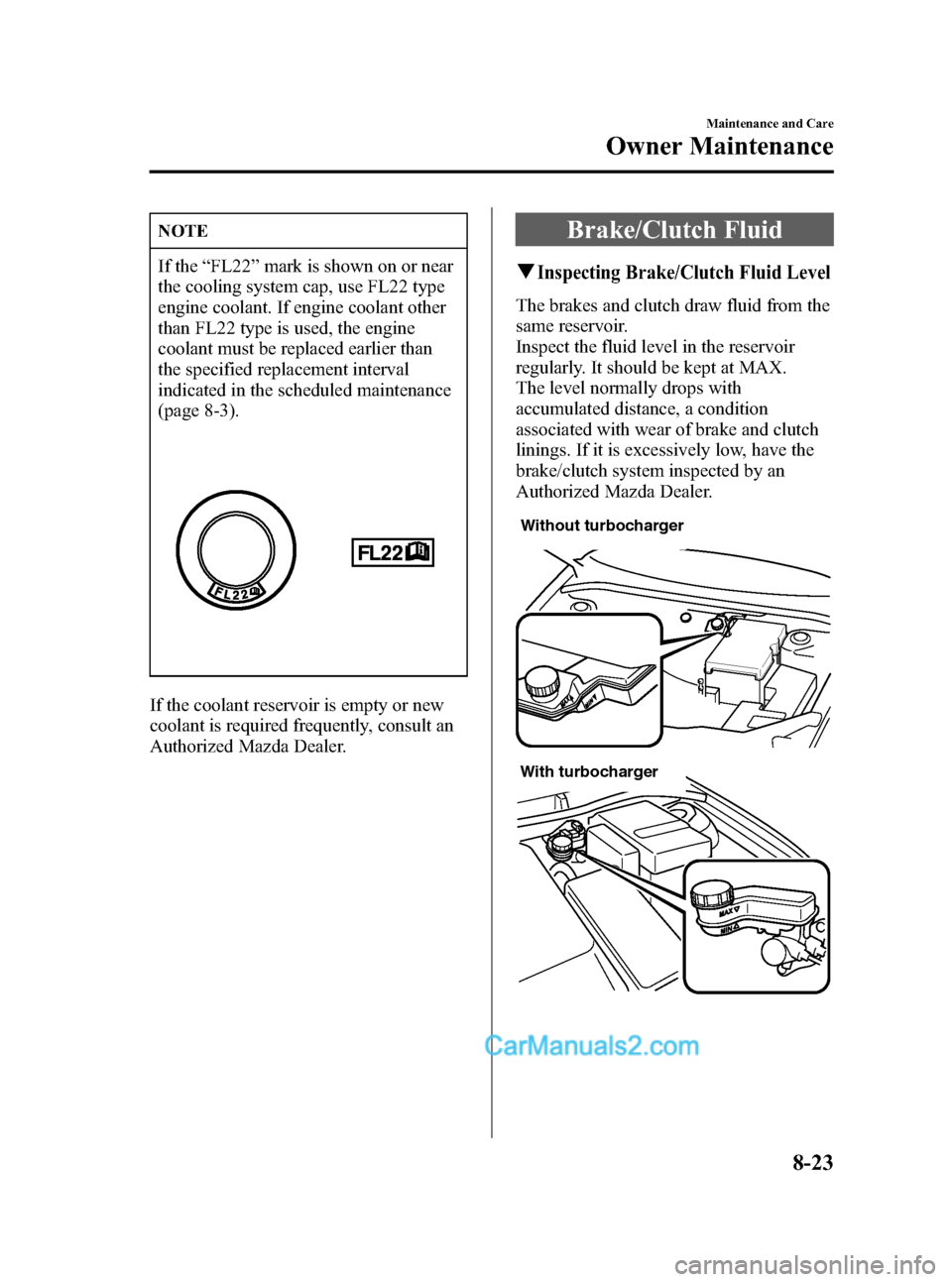
Black plate (297,1)
NOTE
If the“FL22”mark is shown on or near
the cooling system cap, use FL22 type
engine coolant. If engine coolant other
than FL22 type is used, the engine
coolant must be replaced earlier than
the specified replacement interval
indicated in the scheduled maintenance
(page 8-3).
If the coolant reservoir is empty or new
coolant is required frequently, consult an
Authorized Mazda Dealer.
Brake/Clutch Fluid
qInspecting Brake/Clutch Fluid Level
The brakes and clutch draw fluid from the
same reservoir.
Inspect the fluid level in the reservoir
regularly. It should be kept at MAX.
The level normally drops with
accumulated distance, a condition
associated with wear of brake and clutch
linings. If it is excessively low, have the
brake/clutch system inspected by an
Authorized Mazda Dealer.
Without turbocharger
With turbocharger
Maintenance and Care
Owner Maintenance
8-23
Mazda3_8V66-EA-06F_Edition3 Page297
Wednesday, August 23 2006 11:21 AM
Form No.8V66-EA-06F
Page 298 of 402
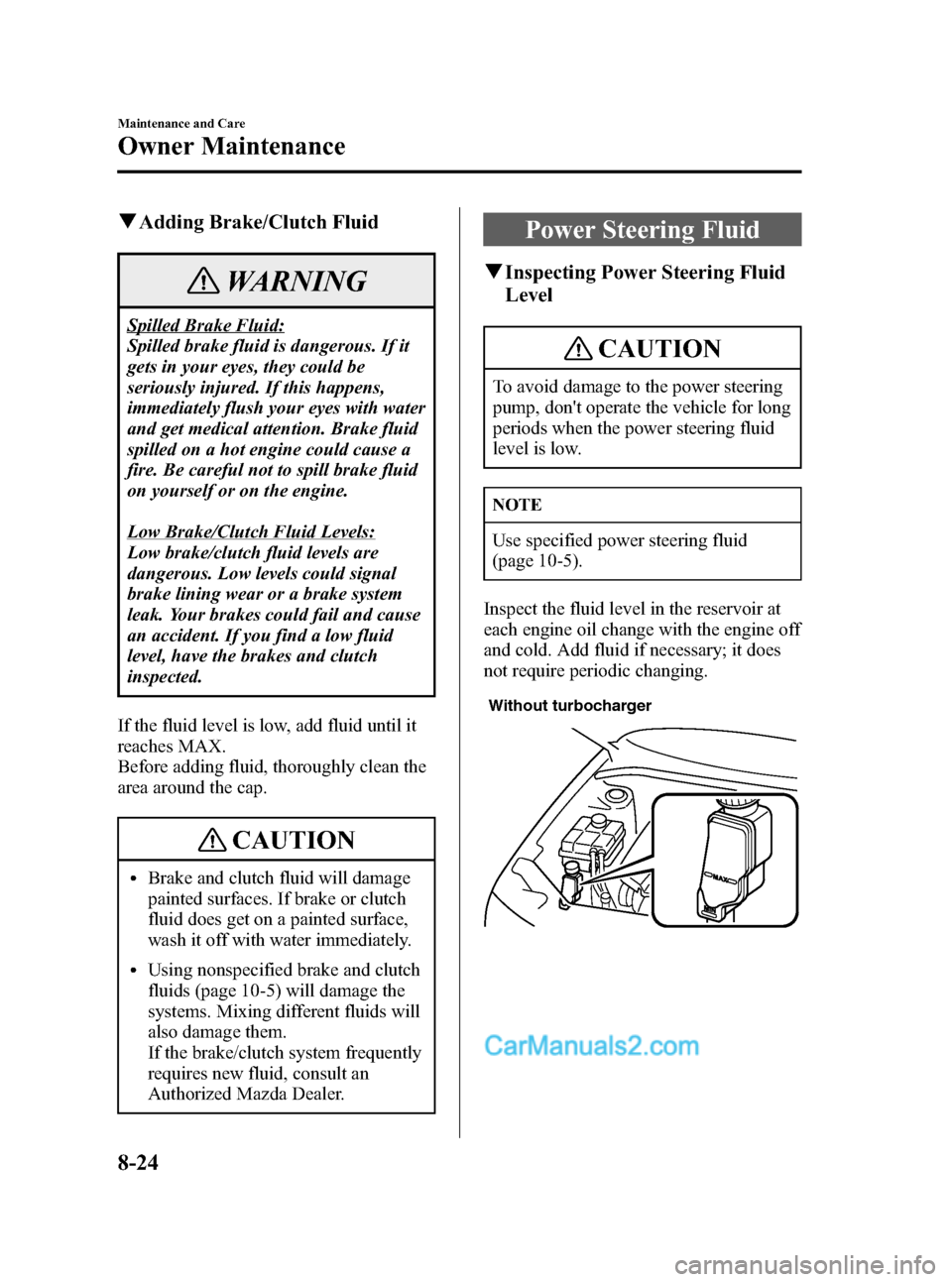
Black plate (298,1)
qAdding Brake/Clutch Fluid
WARNING
Spilled Brake Fluid:
Spilled brake fluid is dangerous. If it
gets in your eyes, they could be
seriously injured. If this happens,
immediately flush your eyes with water
and get medical attention. Brake fluid
spilled on a hot engine could cause a
fire. Be careful not to spill brake fluid
on yourself or on the engine.
Low Brake/Clutch Fluid Levels:
Low brake/clutch fluid levels are
dangerous. Low levels could signal
brake lining wear or a brake system
leak. Your brakes could fail and cause
an accident. If you find a low fluid
level, have the brakes and clutch
inspected.
If the fluid level is low, add fluid until it
reaches MAX.
Before adding fluid, thoroughly clean the
area around the cap.
CAUTION
lBrake and clutch fluid will damage
painted surfaces. If brake or clutch
fluid does get on a painted surface,
wash it off with water immediately.
lUsing nonspecified brake and clutch
fluids (page 10-5) will damage the
systems. Mixing different fluids will
also damage them.
If the brake/clutch system frequently
requires new fluid, consult an
Authorized Mazda Dealer.
Power Steering Fluid
qInspecting Power Steering Fluid
Level
CAUTION
To avoid damage to the power steering
pump, don't operate the vehicle for long
periods when the power steering fluid
level is low.
NOTE
Use specified power steering fluid
(page 10-5).
Inspect the fluid level in the reservoir at
each engine oil change with the engine off
and cold. Add fluid if necessary; it does
not require periodic changing.
Without turbocharger
8-24
Maintenance and Care
Owner Maintenance
Mazda3_8V66-EA-06F_Edition3 Page298
Wednesday, August 23 2006 11:21 AM
Form No.8V66-EA-06F
Page 337 of 402

Black plate (337,1)
CAUTION
lDon't use steel wool, abrasive
cleaners, or strong detergents
containing highly alkaline or caustic
agents on chrome-plated or anodized
aluminum parts. This may damage
the protective coating; also, cleaners
and detergents may discolor or
deteriorate the paint.
lTo prevent damaging the antenna,
remove it before entering a car wash
facility or passing beneath a low
overhead clearance.
Pay special attention to removing salt,
dirt, mud, and other foreign material from
the underside of the fenders, and make
sure the drain holes in the lower edges of
the doors and rocker panels are clean.
Insects, tar, tree sap, bird droppings,
industrial fallout, and similar deposits can
damage the finish if not removed
immediately. When prompt washing with
plain water is ineffective, use a mild soap
made for use on vehicles.
Thoroughly rinse off all soap with
lukewarm or cold water. Don't allow soap
to dry on the finish.
After washing the vehicle, dry it with a
clean chamois to prevent water spots from
forming.
WARNING
Driving with Wet Brakes:
Driving with wet brakes is dangerous.
Increased stopping distance or the
vehicle pulling to one side when
braking could result in a serious
accident. Light braking will indicate
whether the brakes have been affected.
Dry the brakes by driving very slowly
and applying the brakes lightly until
brake performance is normal.
Waxing
Your vehicle needs to be waxed when
water no longer beads on the finish.
Always wash and dry the vehicle before
waxing it. In addition to the vehicle body,
wax the metal trim to maintain its luster.
1. Use wax which contains no abrasives.
Waxes containing abrasive will remove
paint and could damage bright metal
parts.
2. Use a good grade of natural wax for
metallic, mica, and solid colors.
3. When waxing, coat evenly with the
sponge supplied or a soft cloth.
4. Wipe off the wax with a soft cloth.
NOTE
A spot remover to remove oil, tar, and
similar materials will usually also take
off the wax. Rewax these areas even if
the rest of the vehicle doesn't need it.
Maintenance and Care
Appearance Care
8-63
Mazda3_8V66-EA-06F_Edition3 Page337
Wednesday, August 23 2006 11:22 AM
Form No.8V66-EA-06F
Page 338 of 402

Black plate (338,1)
qRepairing Damage to the Finish
Deep scratches or chips on the finish
should be repaired promptly. Exposed
metal quickly rusts and can lead to major
repairs.
CAUTION
If your Mazda is damaged and needs
metal parts repaired or replaced, make
sure the body shop applies anti-
corrosion materials to all parts, both
repaired and new. This will prevent
them from rusting.
qBright-Metal Maintenance
lUse tar remover to remove road tar and
insects. Never do this with a knife or
similar tool.
lTo prevent corrosion on bright-metal
surfaces, apply wax or chrome
preservative and rub it to a high luster.
lDuring cold weather or in coastal areas,
cover bright-metal parts with a coating
of wax or preservative heavier than
usual. It would also help to coat them
with noncorrosive petroleum jelly or
some other protective compound.
CAUTION
Don't use steel wool, abrasive cleaners,
or strong detergents containing highly
alkaline or caustic agents on chrome-
plated or anodized aluminum parts.
This may result in damage to the
protective coating and cause
discoloration or paint deterioration.
qUnderbody Maintenance
Road chemicals and salt used for ice and
snow removal and solvents used for dust
control may collect on the underbody. If
not removed, they will speed up rusting
and deterioration of such underbody parts
as fuel lines, frame, floor pan, and exhaust
system, even though these parts may be
coated with anti-corrosive material.
Thoroughly flush the underbody and
wheel housings with lukewarm or cold
water at the end of each winter. Try also
to do this every month.
Pay special attention to these areas
because they easily hide mud and dirt.It
will do more harm than good to wet
down the road grime without removing
it.
The lower edges of doors, rocker panels,
and frame members have drain holes that
should not be clogged. Water trapped
there will cause rusting.
WARNING
Driving with Wet Brakes:
Driving with wet brakes is dangerous.
Increased stopping distance or the
vehicle pulling to one side when
braking could result in a serious
accident. Light braking will indicate
whether the brakes have been affected.
Dry the brakes by driving very slowly
and applying the brakes lightly until
brake performance is normal.
8-64
Maintenance and Care
Appearance Care
Mazda3_8V66-EA-06F_Edition3 Page338
Wednesday, August 23 2006 11:22 AM
Form No.8V66-EA-06F
Page 370 of 402
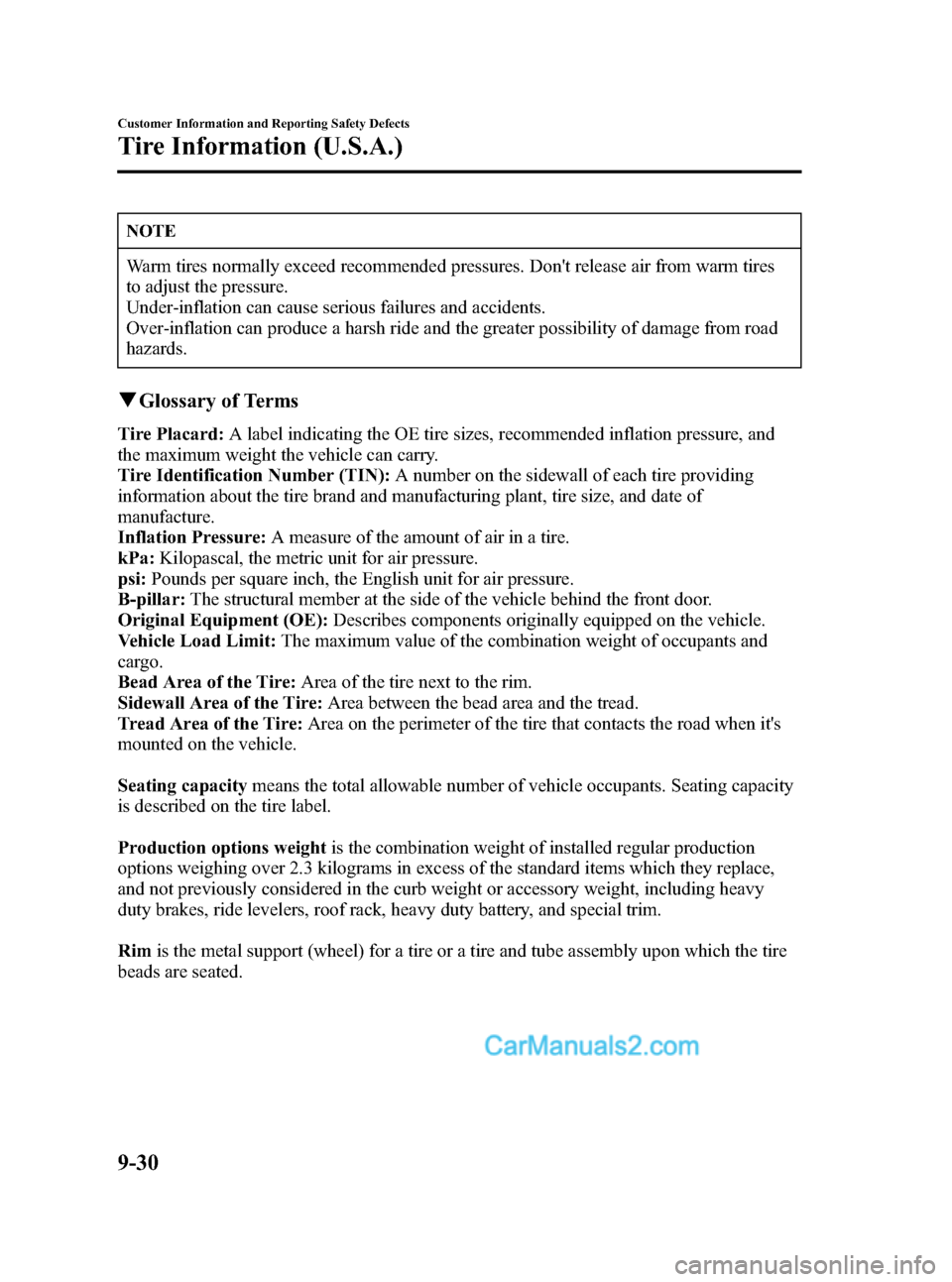
Black plate (370,1)
NOTE
Warm tires normally exceed recommended pressures. Don't release air from warm tires
to adjust the pressure.
Under-inflation can cause serious failures and accidents.
Over-inflation can produce a harsh ride and the greater possibility of damage from road
hazards.
qGlossary of Terms
Tire Placard:A label indicating the OE tire sizes, recommended inflation pressure, and
the maximum weight the vehicle can carry.
Tire Identification Number (TIN):A number on the sidewall of each tire providing
information about the tire brand and manufacturing plant, tire size, and date of
manufacture.
Inflation Pressure:A measure of the amount of air in a tire.
kPa:Kilopascal, the metric unit for air pressure.
psi:Pounds per square inch, the English unit for air pressure.
B-pillar:The structural member at the side of the vehicle behind the front door.
Original Equipment (OE):Describes components originally equipped on the vehicle.
Vehicle Load Limit:The maximum value of the combination weight of occupants and
cargo.
Bead Area of the Tire:Area of the tire next to the rim.
Sidewall Area of the Tire:Area between the bead area and the tread.
Tread Area of the Tire:Area on the perimeter of the tire that contacts the road when it's
mounted on the vehicle.
Seating capacitymeans the total allowable number of vehicle occupants. Seating capacity
is described on the tire label.
Production options weightis the combination weight of installed regular production
options weighing over 2.3 kilograms in excess of the standard items which they replace,
and not previously considered in the curb weight or accessory weight, including heavy
duty brakes, ride levelers, roof rack, heavy duty battery, and special trim.
Rimis the metal support (wheel) for a tire or a tire and tube assembly upon which the tire
beads are seated.
9-30
Customer Information and Reporting Safety Defects
Tire Information (U.S.A.)
Mazda3_8V66-EA-06F_Edition3 Page370
Wednesday, August 23 2006 11:22 AM
Form No.8V66-EA-06F
Page 374 of 402
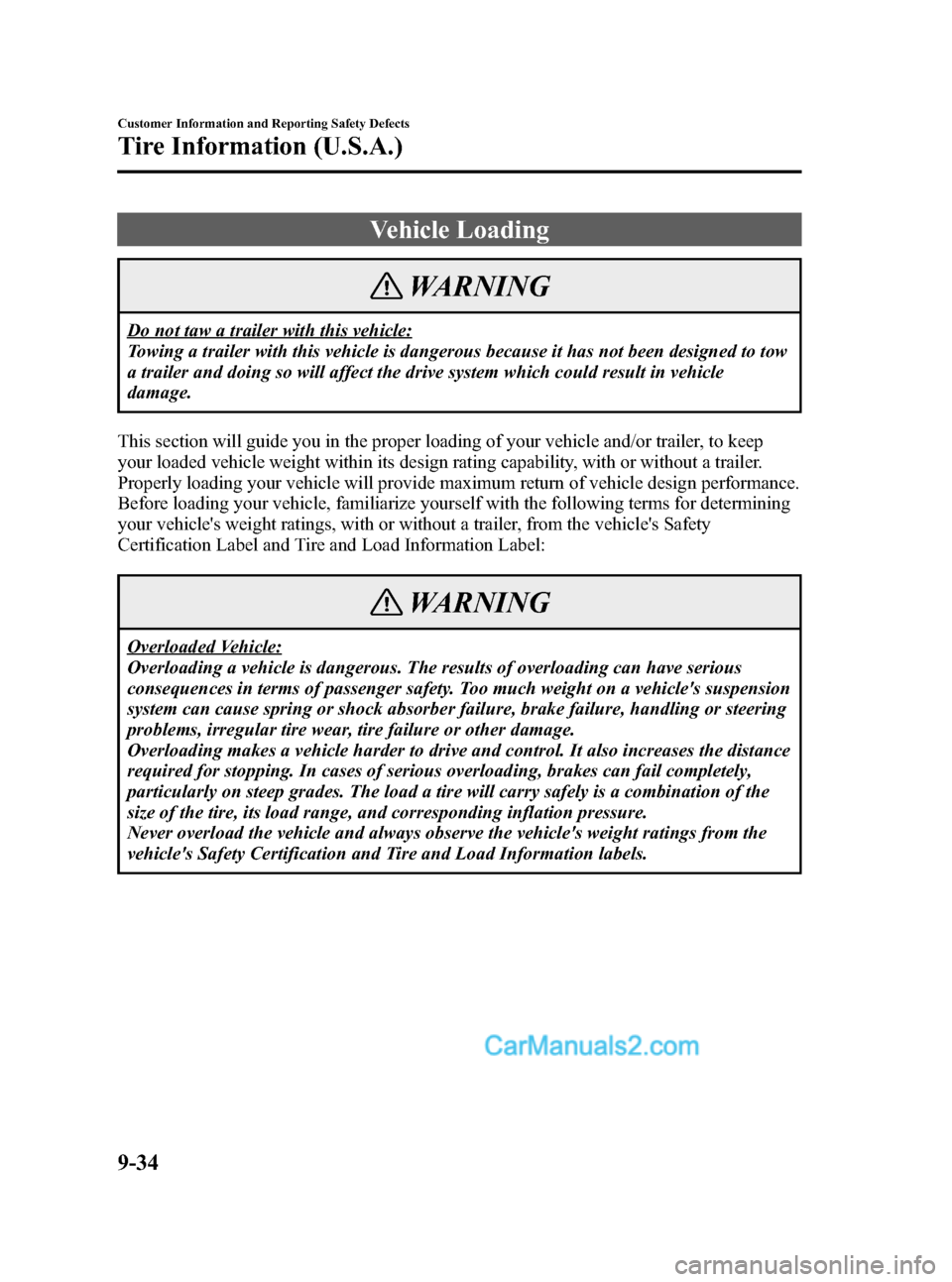
Black plate (374,1)
Vehicle Loading
WARNING
Do not taw a trailer with this vehicle:
Towing a trailer with this vehicle is dangerous because it has not been designed to tow
a trailer and doing so will affect the drive system which could result in vehicle
damage.
This section will guide you in the proper loading of your vehicle and/or trailer, to keep
your loaded vehicle weight within its design rating capability, with or without a trailer.
Properly loading your vehicle will provide maximum return of vehicle design performance.
Before loading your vehicle, familiarize yourself with the following terms for determining
your vehicle's weight ratings, with or without a trailer, from the vehicle's Safety
Certification Label and Tire and Load Information Label:
WARNING
Overloaded Vehicle:
Overloading a vehicle is dangerous. The results of overloading can have serious
consequences in terms of passenger safety. Too much weight on a vehicle's suspension
system can cause spring or shock absorber failure, brake failure, handling or steering
problems, irregular tire wear, tire failure or other damage.
Overloading makes a vehicle harder to drive and control. It also increases the distance
required for stopping. In cases of serious overloading, brakes can fail completely,
particularly on steep grades. The load a tire will carry safely is a combination of the
size of the tire, its load range, and corresponding inflation pressure.
Never overload the vehicle and always observe the vehicle's weight ratings from the
vehicle's Safety Certification and Tire and Load Information labels.
9-34
Customer Information and Reporting Safety Defects
Tire Information (U.S.A.)
Mazda3_8V66-EA-06F_Edition3 Page374
Wednesday, August 23 2006 11:22 AM
Form No.8V66-EA-06F
Page 379 of 402
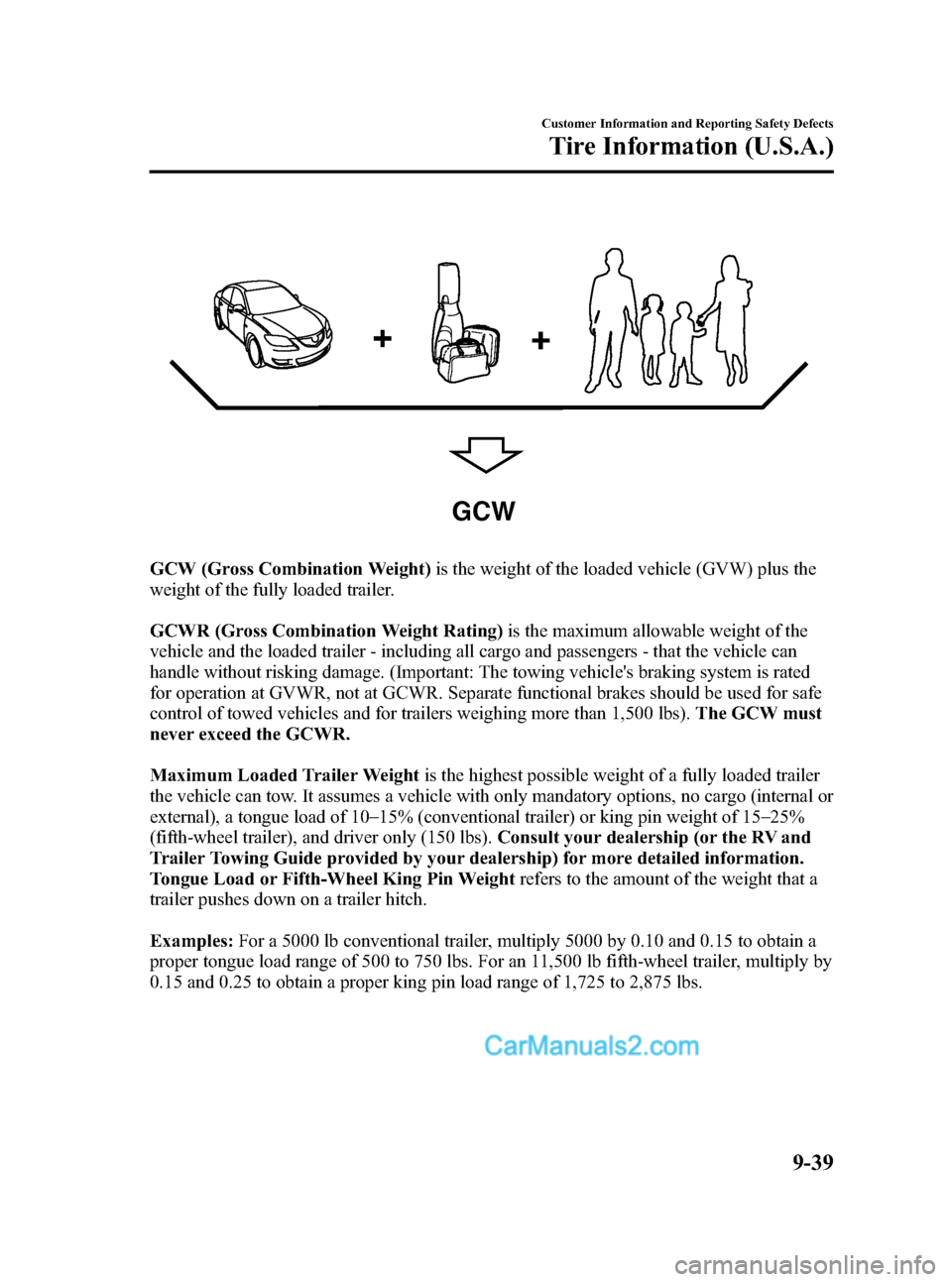
Black plate (379,1)
GCW
GCW (Gross Combination Weight)is the weight of the loaded vehicle (GVW) plus the
weight of the fully loaded trailer.
GCWR (Gross Combination Weight Rating)is the maximum allowable weight of the
vehicle and the loaded trailer - including all cargo and passengers - that the vehicle can
handle without risking damage. (Important: The towing vehicle's braking system is rated
for operation at GVWR, not at GCWR. Separate functional brakes should be used for safe
control of towed vehicles and for trailers weighing more than 1,500 lbs).The GCW must
never exceed the GCWR.
Maximum Loaded Trailer Weightis the highest possible weight of a fully loaded trailer
the vehicle can tow. It assumes a vehicle with only mandatory options, no cargo (internal or
external), a tongue load of 10_
15% (conventional trailer) or king pin weight of 15_
25%
(fifth-wheel trailer), and driver only (150 lbs).Consult your dealership (or the RV and
Trailer Towing Guide provided by your dealership) for more detailed information.
Tongue Load or Fifth-Wheel King Pin Weightrefers to the amount of the weight that a
trailer pushes down on a trailer hitch.
Examples:For a 5000 lb conventional trailer, multiply 5000 by 0.10 and 0.15 to obtain a
proper tongue load range of 500 to 750 lbs. For an 11,500 lb fifth-wheel trailer, multiply by
0.15 and 0.25 to obtain a proper king pin load range of 1,725 to 2,875 lbs.
Customer Information and Reporting Safety Defects
Tire Information (U.S.A.)
9-39
Mazda3_8V66-EA-06F_Edition3 Page379
Wednesday, August 23 2006 11:22 AM
Form No.8V66-EA-06F
Page 396 of 402
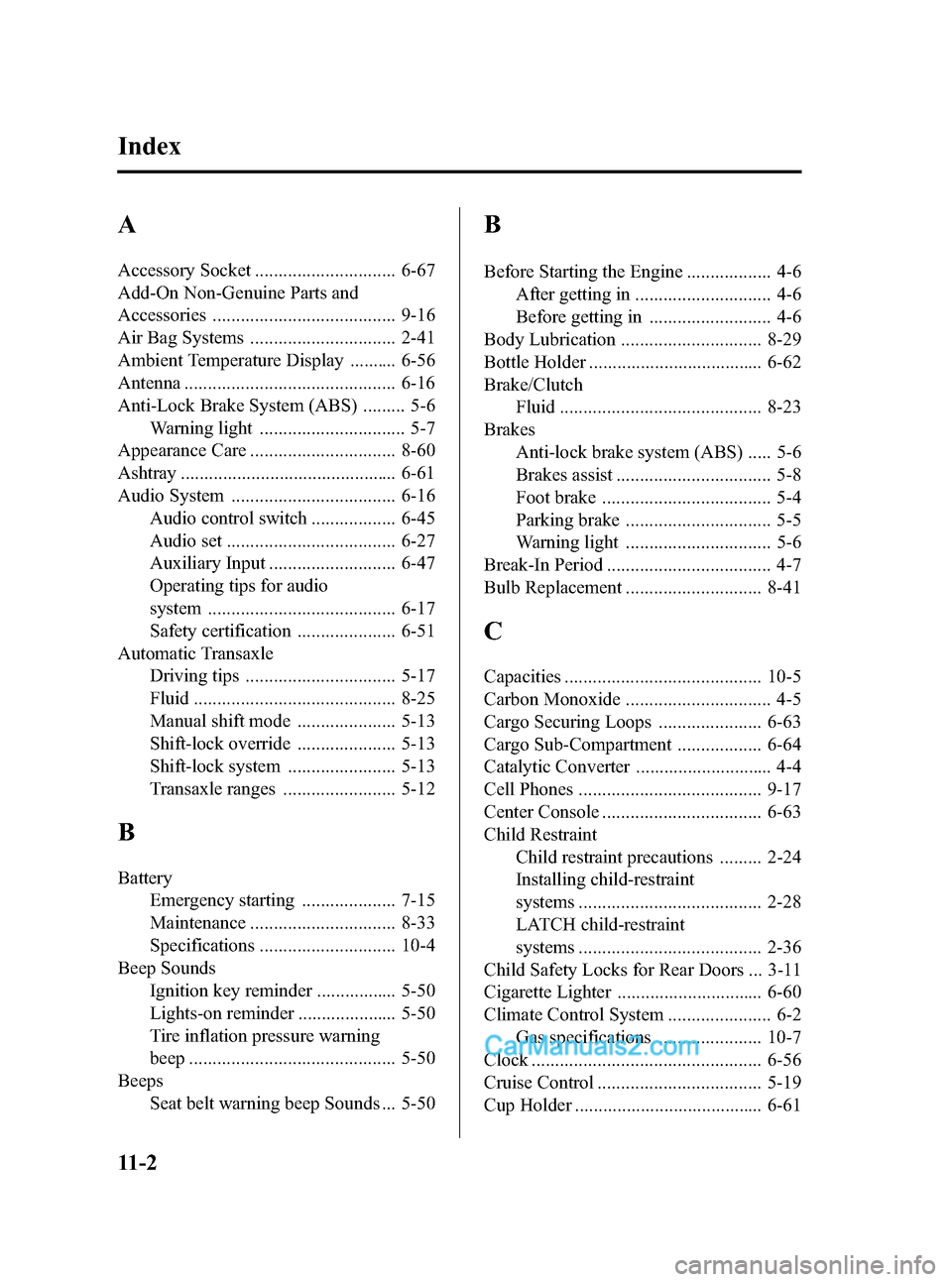
Black plate (396,1)
A
Accessory Socket .............................. 6-67
Add-On Non-Genuine Parts and
Accessories ....................................... 9-16
Air Bag Systems ............................... 2-41
Ambient Temperature Display .......... 6-56
Antenna ............................................. 6-16
Anti-Lock Brake System (ABS) ......... 5-6
Warning light ............................... 5-7
Appearance Care ............................... 8-60
Ashtray .............................................. 6-61
Audio System ................................... 6-16
Audio control switch .................. 6-45
Audio set .................................... 6-27
Auxiliary Input ........................... 6-47
Operating tips for audio
system ........................................ 6-17
Safety certification ..................... 6-51
Automatic Transaxle
Driving tips ................................ 5-17
Fluid ........................................... 8-25
Manual shift mode ..................... 5-13
Shift-lock override ..................... 5-13
Shift-lock system ....................... 5-13
Transaxle ranges ........................ 5-12
B
Battery
Emergency starting .................... 7-15
Maintenance ............................... 8-33
Specifications ............................. 10-4
Beep Sounds
Ignition key reminder ................. 5-50
Lights-on reminder ..................... 5-50
Tire inflation pressure warning
beep ............................................ 5-50
Beeps
Seat belt warning beep Sounds ... 5-50
B
Before Starting the Engine .................. 4-6
After getting in ............................. 4-6
Before getting in .......................... 4-6
Body Lubrication .............................. 8-29
Bottle Holder ..................................... 6-62
Brake/Clutch
Fluid ........................................... 8-23
Brakes
Anti-lock brake system (ABS) ..... 5-6
Brakes assist ................................. 5-8
Foot brake .................................... 5-4
Parking brake ............................... 5-5
Warning light ............................... 5-6
Break-In Period ................................... 4-7
Bulb Replacement ............................. 8-41
C
Capacities .......................................... 10-5
Carbon Monoxide ............................... 4-5
Cargo Securing Loops ...................... 6-63
Cargo Sub-Compartment .................. 6-64
Catalytic Converter ............................. 4-4
Cell Phones ....................................... 9-17
Center Console .................................. 6-63
Child Restraint
Child restraint precautions ......... 2-24
Installing child-restraint
systems ....................................... 2-28
LATCH child-restraint
systems ....................................... 2-36
Child Safety Locks for Rear Doors ... 3-11
Cigarette Lighter ............................... 6-60
Climate Control System ...................... 6-2
Gas specifications ...................... 10-7
Clock ................................................. 6-56
Cruise Control ................................... 5-19
Cup Holder ........................................ 6-61
11-2
Index
Mazda3_8V66-EA-06F_Edition3 Page396
Wednesday, August 23 2006 11:22 AM
Form No.8V66-EA-06F